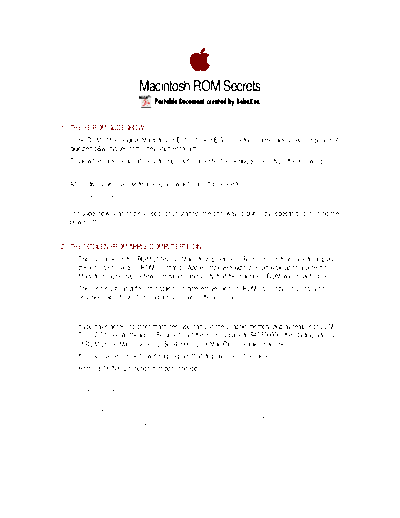Service Manuals, User Guides, Schematic Diagrams or docs for : apple SecretROMStuff
<< Back | HomeMost service manuals and schematics are PDF files, so You will need Adobre Acrobat Reader to view : Acrobat Download Some of the files are DjVu format. Readers and resources available here : DjVu Resources
For the compressed files, most common are zip and rar. Please, extract files with Your favorite compression software ( WinZip, WinRAR ... ) before viewing. If a document has multiple parts, You should download all, before extracting.
Good luck. Repair on Your own risk. Make sure You know what You are doing.
Image preview - the first page of the document

>> Download SecretROMStuff documenatation <<
Text preview - extract from the document
Macintosh ROM Secrets
1) THE SE ROM SLIDESHOW
In the ROM of the original Macintosh SE (*not* the SE/30!) is a four-frame slideshow composed of
digitized b&w images of the development team.
To view the slideshow, hit the interrupt switch to enter the debugger, and type the following:
G 41D89A .
Alternatively, you can write a program which calls this procedure:
PROCEDURE DoIt;
Inline $4EF9, $0041, $D89A; { jmp $41D89A }
The slideshow is an endless loop; once started, the only way to quit is by rebooting (or turning the
power off).
2) THE "STOLEN FROM APPLE COMPUTER" ICON
This icon lurks in the ROM of *every* Macintosh produced. Rumor has it that code to display
this icon also exists in ROM, so that an Apple employee/wizard could walk up to a potential
Macintosh clone, type a few commands, and verify that the machine's ROM was in fact "stolen".
This icon exists at different locations in different versions of ROM; currently, yours truly has
only been able to verify its existence in two of those versions:
ROM Version 117, rev.1-3 (Macintosh Plus): $0040E132
ROM Version 120, rev. 3 (Macintosh IIx, IIcx, SE/30): $408A065A
If you have access to other machines, you can use the Graphic memory display feature of SUM II
Tools 2.0 to locate the icon. (Be sure to set the memory base to $40800000, the starting address
of ROM on the Mac II series, or $00400000 on a Mac Plus or earlier machine.)
It's reasonable simple to write a program that displays the "stolen icon".
Here's a THINK C function that does the job:
PlotStolenIcon(inRect)
Rect *inRect;
{
asm {
BRA.S @2
@1 DC.L 0x40E132 ;address of icon (Mac Plus ROM only!)
@2 MOVE.L inRect,-(SP) ;push rect argument
PEA @1 ;push "handle" to icon
DC.W 0xA94B ;_PlotIcon
}
}
3) HIDDEN COLOR PICTURES IN THE IIci AND Iifx
The 512K ROM (also known as the first "32-Bit Clean" ROM) introduced with the Macintosh IIci
evidently had some extra room for fun.
On the IIci, do the following:
A) Go into the Control Panel and set the date to Sept. 20, 1989 (9/20/89 -- this just happens to
be the machine's release date.)
B) Reboot and hold down cmd-option-c-i (yes, all 4 keys simultaneously.)
C) Surprise! Up pops a color picture of some Apple employees!
On the IIfx, the procedure is similar:
A) Set the date to March 19, 1990 (3/19/90 -- the release date.)
B) Reboot while holding down cmd-option-f-x.
C) Yes, it's another color picture!
4) HIDDEN STARTUP DISK IN CLASSIC ROM
The Macintosh Classic has an "undocumented feature": a complete, bootable system "disk" in
ROM. This was an experiment in creating a "diskless workstation" machine that apparently wasn't
considered important enough to mention as a feature. Rumor has it that the Macintosh LC and
IIsi also contain a hidden ROM disk, but this has not yet been verified.
To access the hidden disk, reboot the Macintosh Classic while holding down cmd-option-x-o.
When the Finder comes up, the ROM disk should appear on the desktop. Note that you can use
the Startup Device cdev to specify this disk as the startup device; subsequently, the machine will
boot from ROM without the need for a "real" startup disk (handy, if you've only got one floppy
disk drive.)
Macintosh ROM Secrets Page 2
◦ Jabse Service Manual Search 2024 ◦ Jabse Pravopis ◦ onTap.bg ◦ Other service manual resources online : Fixya ◦ eServiceinfo